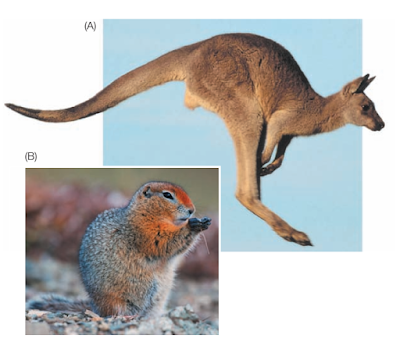Cells use nutrients to supply energy andto build new structures
Living organisms acquire nutrients from the environment. Nutrients supply the organism with energy and raw materials forcarrying out biochemical reactions. Life depends on thousands
of biochemical reactions that occur inside cells. Some of these
reactions break down nutrient molecules into smaller chemical
units, and in the process some of the energy contained in the
chemical bonds of the nutrients is captured by high-energy molecules that can be used to do different kinds of cellular work.
One obvious kind of work cells do is mechanical—moving
molecules from one cellular location to another, moving whole
cells or tissues, or even moving the organism itself, as muscles
do (Figure 1.5A). The most basic cellular work is the building,
or synthesis, of new complex molecules and structures from
smaller chemical units. For example, we are all familiar with the
fact that carbohydrates eaten today may be deposited in the
body as fat tomorrow (Figure 1.5B). Still another kind of work
is the electrical work that is the essence of information processing in nervous systems. The sum total of all the chemical
transformations and other work done in all the cells of an organism is its metabolism, or metabolic rate.
The myriad of biochemical reactions that go on in cells are
integrally linked in that the products of one are the raw materials of the next. These complex networks of reactions must be
integrated and precisely controlled; when they are not, the result is disease.Living organisms regulate their internal environmentMulticellular organisms have an internal environment that is not
cellular. That is, their individual cells are bathed in extracellular fluids, from which they receive nutrients and into which they
excrete waste products of metabolism. The cells of multicellu lar organisms are specialized, or differentiated, to contribute in
some way to the maintenance of the internal environment. With
the evolution of specialization, differentiated cells lost many
of the functions carried out by single-celled organisms, and
must depend on the internal environment for essential services.
To accomplish their specialized tasks, assemblages of differentiated cells are organized into tissues. For example, a single
muscle cell cannot generate much force, but when many cells
combine to form the tissue of a working muscle, considerable
force and movement can be generated (see Figure 1.5B). Different tissue types are organized to form organs that accomplish
specific functions. For example, the heart, brain, and stomach
are each constructed of several types of tissues. Organs whose
functions are interrelated can be grouped into organ systems; the
stomach, intestine, and esophagus, for example, are parts of the
digestive system. The functions of cells, tissues, organs, and organ systems are all integral to the multicellular organism. We
cover the biology of organisms in Parts Eight and Nine of this
| book |

Comments
Post a Comment